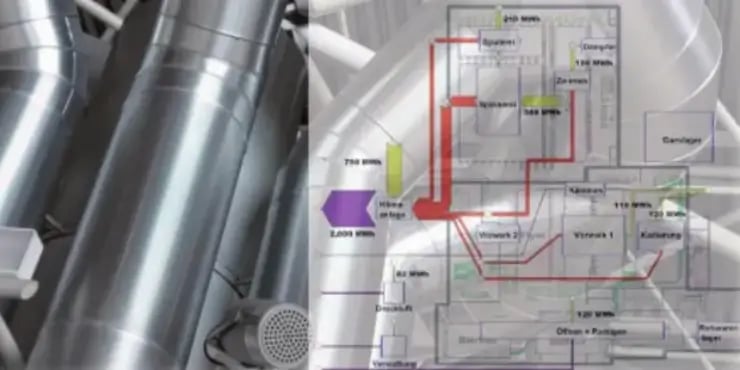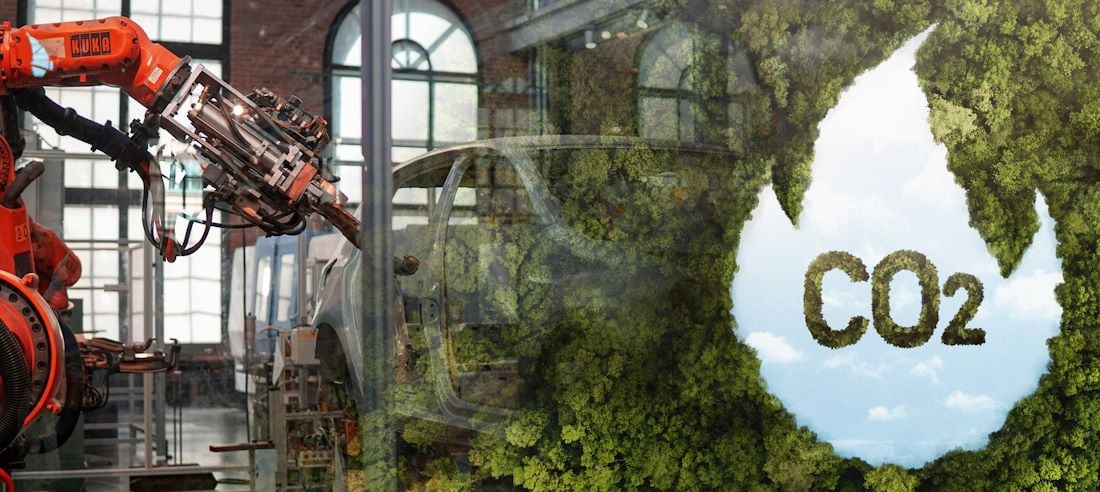How, exactly, can a medium-sized industrial company save on energy without negatively affecting production? What are the concrete measures that were taken by a textile company in Germany to increase energy efficiency by ten percent? What approach is needed to calculate the true amortization period for investments in efficiency? Find the answers in this article.
Tobias Viere, the brain behind the Enhipro project, knows many ways to achieve “Energy and additive optimized production”. That is what his project deals with, dubbed after the German, “Energie- und hilfstoffoptimierte Produktion” (En-hi-pro). Together with the Institute of Machine Tools and Production Technology at the Technical University Braunschweig, and with the help of Germany’s Federal Ministry of Education and Research, which funded the project, Tobias Viere explored ways to improve material and energy efficiency. That’s his job as Head of Research & Consulting at ifu Hamburg GmbH. Through Enhipro, he discovered some evident, and some surprising, methods for improvement. This article will spotlight all of them.
No other place than the Black Forest is where SWU Textil GmbH runs its business. With 100 employees and a 150-year-old tradition, the company knows how yarns are spun and technical materials are produced. Abrasive textiles and printing blankets are some of the products that consume a lot of energy because production processes only work well in a very small range of temperatures and humidities.
Even though the uber-idyllic location in Baden-Württemberg and the company’s long tradition suggest imperturbable continuity, some new trends do overtake the business and call for change. Four gigawatt hours of energy consumption a year sum up to nearly 400,000 euros (~500,000 USD)! That’s why Tobias Viere outlines the importance of efficiency measures:
In light of increasing energy prices, as well as national and international efforts towards climate protection, the continuous increase of energy efficiency for cooling and climate control needs is of utmost strategic importance for SWU.
Not only rising energy costs, but also competitors from overseas challenge the company:
In view of lower wage and energy costs that beckon in other countries, SWU GmbH must continuously increase their energy and resource efficiency in order to remain competitive.
SWU is not the only company striving to increase its production line efficiency and, luckily, projects like Enhipro show ways they can do so. So what can be done? First of all, there are some easy measures every company can carry out. To evaluate their usefulness, measuring the consumption of every production step and of every machine is inevitable. Tobias Viere:
The analysis is relying on detailed energy readings of individual facility sections as well as on continuous readings of comprehensive consumption. The readings form a part of both production data acquisition and production planning and provide the basis for an ecological and economical evaluation of various efficiency measures.
Adjust Cooling Rotor Blades, Improve Insulation, Repair Air Pressure Leaks
Have you ever realized that the rotor blades of your cooling units can be aligned in different ways? You should. Their optimization provides considerable energy saving potential. Moreover, all individual components of the cooling units should get checked for possible insulation gaps. Air pressure leaks, too, are a common source of energy waste. Material efficiency can be increased by recycling spare materials. Another tactic is to reduce the operating time of dust collection units – they may not be needed on a non-stop basis.
Measure Continuously
Speaking of which – operation bears the most potential for improvement. We can find out just how much there is by analyzing the production system’s status quo. But before getting into the details about operational improvement, let’s find out how to assess the effectiveness of the above-mentioned measures. Tobias Viere proposes a convenient way to do so:
Through ongoing measurement of the facility’s energy consumption, changes in the load profile are immediately detected and the causes can then be removed.
Go With the Seasons
Improving operation can be done in various ways. The easiest way is to work with the seasons. If your production runs allow for a certain flexibility, and if peak temperature periods in the summer months are short, like in Central and Northern Europe, just wait until it gets cooler to run operations that generate a lot of excess heat. In the case of SWU’s textile production, it goes like this:
For example, plying the yarn, a particularly energy intensive process that doesn’t run continuously, can be planned so as to utilize times other than the hot summer months. By not running the yarn plying machines during the months when air conditioners are in use, energy use for cooling can be easily and significantly reduced.
Follow An Integrative Approach
According to Tobias Viere, an integrative, rather than isolated, approach leads to changes in important parameters regarding investment decisions. The sophisticated process maps that are generated by material flow software, visualize the whole production system and its sub-processes. The Sankey diagram created using the software helps not only the engineers, but also the accountants and top-level decision makers to fully understand what’s happening on the factory floor. For an extensive collection of Sankey-diagrams, visit the sankey-diagrams.com blog.
Tobias Viere explains the benefits of this software:
With the help of the Umberto material flow management software, a systematic look at the costs as well as primary energy and materials use can be achieved, assigning each to individual product groups. This integrative method allows, for example, illustration of the connection between production and air conditioning: the more often the machines used for spinning, spooling, plying or steaming are run, the more waste heat is generated. That, in turn, has to be removed by the ventilation and air conditioning units, which, of course, require an input of energy.
Redesigned Process Structure
Calculating the connections between all inputs, processes, and outputs is what the Umberto software does. For the outputs, both the desired ones (products) and the undesired ones (emissions) become clear, as do their respective “consumptions” of input.
A systematic analysis allows us to redesign the production process and reap efficiency rewards. For example:
Processes which don’t require a specific temperature and humidity level, such as steaming the yarn, can be excluded from climate controlled areas.
Include Secondary Processes
The integrative approach regards not only the energy consumption of a certain machine (and its more efficient successor), but also the savings related to the smaller demand for temperature control because the more efficient machine is very likely to generate less waste heat. Exclusively looking at primary processes affects the correct allocation of savings. Much better, Viere’s integrative approach includes secondary processes, too:
[E]fficiency can be further increased by optimizing climate control equipment utilization. This new viewpoint regarding cooling and climate control is part of the integrated analysis of all SWU production systems, which – in addition to the actual production processes – also includes secondary processes such as air pressure and steam generation.
And that’s what makes precise investment decisions possible:
Operating expenses for air conditioning, but also for other sub-processes such as steam and air pressure generation, can be directly considered when estimating costs for specific products or jobs.
To conclude, and maybe to finally persuade you of the sense Viere’s approach makes, the following image shows an investment table. It compares an isolated approach, which focuses only on a new, energy efficient motor, with an integrative approach that also includes the savings connected to the ventilation and air conditioning units related to the use of the new motor.
More Information
- IT&Production article by Tobias Viere (PDF): Optimal cooling and cost management – Climate control technology on the factory floor
- EnHiPro project homepage: www.enhipro.de (in German)
- EnHiPro presentation from Hannover Messe (PDF, in German), providing many illustrating images and diagrams: Von der Messung bis zur Optimierung – Integration von Energie- und Ressourceneffizienz in Produktionssysteme und Planung
- Book “Advances in Sustainable Manufacturing“ by Seliger, Khraisheh and Jawahir. EnHiPro is taken as an example for holistic thinking, see page 27 on Google Books
- More research projects by Tobias Viere and contact information: www.ifu.com/en/research/research-projects
- SWU Textil GmbH (in German): www.swu-textil.de
- Institute of Machine Tools and Production Technology at the Technical University Braunschweig, website in German: www.iwf.tu-bs.de






